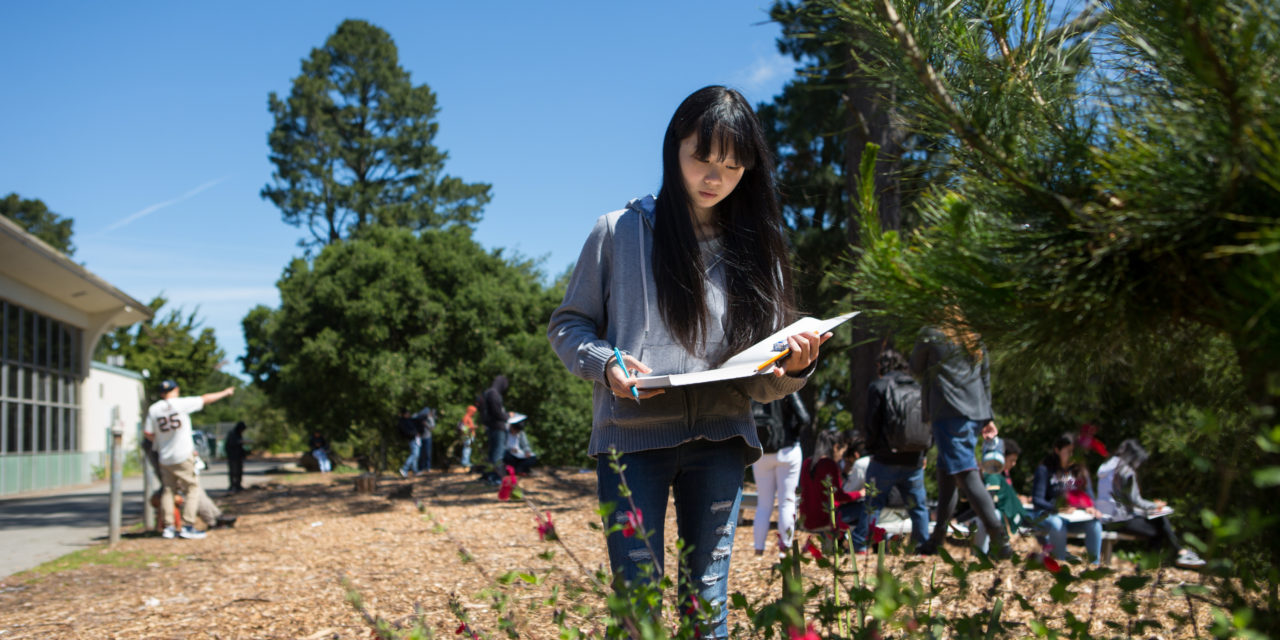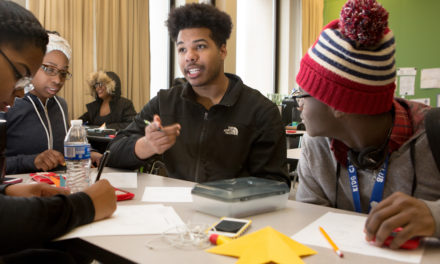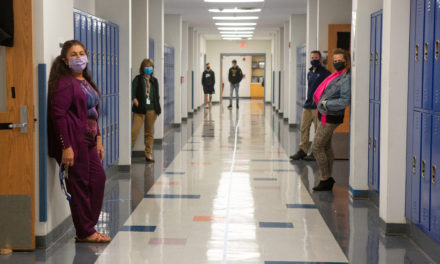When Darlene Kamine tells the story about Oyler School in Cincinnati, Ohio, she also likes to tell the story about the house across the street from the school.
Kamine and the group she leads, the Community Learning Center Institute (CLCI), have played leading roles in the startling comeback of Oyler School, which is a pre-K through grade 12 school that sits at the center of Cincinnati’s Lower Price Hill (LPH) neighborhood. The historic district west of downtown became a destination for Appalachian families looking for factory work, “[w]hen coal mining jobs in Kentucky and West Virginia declined after World War II,” reported Amy Scott for Contexts, a peer-reviewed academic journal. But since the 1980s, the district “has seen a severe decline in population, businesses, and investment,” according to the LPH Resurgency Plan, a civic planning document approved by the Cincinnati City Council in 2019. “[S]uburban sprawl and economic decline had devastating effects on the neighborhood,” making LPH “one of the poorest neighborhoods in the City of Cincinnati,” noted the plan.
When Kamine and her organization began working with Oyler in 2009, 85 percent of the students weren’t making it through 10th grade, she said. Today, the school has a 92.7 percent graduation rate, and 70 percent of graduates go to college, despite the district’s continued high poverty rate.
Kamine credits much of the success to two things: a $21 million investment into refurbishing the aged, well-worn school building and the implementation of a school improvement approach called community schools.
Transforming Public Schools Into Community Hubs
The community schools approach, according to Kamine, relies on transforming public schools into community hubs of educational, recreational, cultural, health, and civic partnerships, which work in unison to improve the conditions for student learning and family and community well-being. The approach requires local school decision-making committees to assess the needs of the school, select the appropriate partnerships, and ensure that the desired outcomes are financially self-sustaining.
At Oyler, implementing the community schools approach resulted in the school providing “a health clinic staffed by a nurse practitioner, a vision center where children can get free eye exams and glasses, a dental clinic, and mental health counselors,” Scott stated in her 2015 article. “Kids can eat breakfast, lunch, and dinner at school, and bring home food for the weekends. Enrichment programs include college advising, after-school activities, and a large network of volunteer tutors and mentors. All these partnerships are self-sustaining. The school provides the space; the organizations tap their own budgets or bill Medicaid for their services.”
Due to the success of Oyler and other schools like it, more Cincinnati schools have caught on to the community schools approach. CLCI now works with six schools, and the Cincinnati Public Schools (CPS) district, whose community schools effort dates back to 2002, says 44 of its 65 total schools are “community learning centers,” the district’s preferred term for schools using this approach.
Since its adoption of the community school’s approach, CPS has become Ohio’s “highest-ranked urban school district,” according to Greg Anrig, a senior fellow at the Century Foundation. In a 2015 article in Educational Leadership, Anrig wrote, “Cincinnati’s test scores went from being on a par with those of other struggling school districts… to breaking away from the pack. In 2009-10, Cincinnati became the first city to receive effective ratings on the Ohio District Report Card… even as poverty rates increased in the city.”
“CPS consistently ranks No. 1 among Ohio’s eight large urban school districts,” WCPO 9 reported in 2016. “That means when compared to Ohio’s other seven large urban districts—Akron, Canton, Cleveland, Columbus, Dayton, Toledo, and Youngstown—CPS is actually the best of the bunch.”
But Kamine wants people to know the community schools approach’s success story in Cincinnati is not just about what goes on in schools. “Schools can create the conditions for learning within their schools,” she said, “but they can’t be islands in their neighborhoods.”
‘Where Community Revitalization Starts’
Even as positive change started to take root at Oyler, students and parents wanted to do something about the dilapidated, abandoned house across the street from the school. “The house had become a constant reminder to the Oyler community that, ‘You are not yet worthy,’” Kamine said, and teachers and school staff realized something had to be done about it.
Their first step was to get a grant to purchase and renovate the house. Then, based on conversations with the Oyler community and nearby homeowners, a decision was made to make the house into an extension of the school’s campus to provide a meeting space, a food pantry, and classes in home ownership and maintenance and other educational topics.
Now known as Oyler House, the renovated structure, which “had once been a symbol of the blight that has plagued the neighborhood for decades,” instead “conveys hope” about where the community is heading, according to the Hamilton County Land Reutilization Corporation, a landbank that returns vacant properties to productive use.
In addition to renovating Oyler House, CLCI has helped start housing initiatives in Lower Price Hill and elsewhere, including urban homesteading, affordable rental housing, and renovations of old historic homes that had been abandoned or poorly maintained. According to Kamine, these initiatives have eliminated homelessness in all CLCI-assisted schools, and 30 families are currently in the pipeline to buy new homes.
“The progress at these schools has attracted three companies to move into these communities, which has brought 350 new jobs,” Kamine said, and school improvements have catalyzed other neighborhood improvements, including new streetscapes with sidewalks and lighting.
“Schools are good places for where community revitalization starts,” she said, “because they have buildings that [are in] close proximity to families, and schools are already where the kids are.”
New Academic Pathways for Student Learning
Grant Schuster tells a similar story about a school in Anaheim, California, whose success with the community schools approach became the catalyst for revitalizing the surrounding community.
According to Schuster, who is president of the Anaheim Secondary Teachers Association, the Anaheim Union High School District officially adopted the community schools approach in 2020 when it announced the hiring of a community school coordinator for two of its schools, Anaheim Union High School and Sycamore Junior High School.
But the idea had taken hold in the district years earlier when the district was awarded grant money to recruit a steering committee to explore the adoption of the approach and rewrite school policies and job descriptions to encompass the community schools philosophy, including providing students with wraparound services and an inclusive curriculum that allowed for potential new academic pathways for student learning.
In Magnolia High School, one such pathway opened when students, nearly all of whom qualified for free or reduced-price school meals, started asking teachers why the neighborhood surrounding the school had so many liquor stores but no grocery stores.
Those discussions led to learning about food deserts, why they are so often a feature of low-income communities, and how the issue connects to social justice, environmental science, and sustainable agricultural practices.
Then, teachers and students worked with school leaders to expand their inquiries into creating the school’s own agriscience community center. Working with local officials and nonprofits, the school acquired a 2.5-acre plot of land for the students to learn how to grow nutritious fruits and vegetables, not only for their own school meals but also for distributing to the surrounding community.
‘A Ripple Effect’
“When a school is successful, it has a ripple effect on the surrounding community,” said Allen Weeks. Weeks, who is the executive director of Austin Voices for Education and Youth, helped spearhead successful community schools reform at Webb Middle School and Reagan High School in Austin, Texas.
Reagan High School is now called Northeast Early College High Schoolafter a name change taking place during the 2019-2020 school year, but in 2008, the once-proud school built in the 1960s had become gradually surrounded by Austin’s most drug-infested neighborhood, according to Weeks. “Every system at [the school] had broken down,” he said, and the school was being threatened with closure.
“Saving Reagan [now Northeast] became a community focus,” according to Weeks, and educators at the school began looking into the community schools approach as a strategy for turning the school around.
Their first step was to get funding from the district to attend a community schools conference in Portland, Oregon, where they learned how to implement the approach at their school. Also, Northeast school leaders worked with district leaders to form committees consisting of a wide range of stakeholders in the community to determine major areas to address.
Those committees identified 11 major areas to work on, including the school’s high mobility rate—with high proportions of the students coming and going from the school, often in midyear—and the need to start a family resource center at the school. The center quickly developed 30 partnerships with local nonprofits to provide access to services such as mobile health clinics, mental health services, parenting classes, and after-school programs for students.
A year after opening the resource center, mobility rates at Northeast Early College High School dropped by a third, according to Weeks, the school doubled enrollment, and graduation rates improved from 48 percent to 98 percent in five years. More recently, the school partnered with a local community college to offer courses that enable the students at Northeast to earn credits toward an associate’s degree before they graduate high school.
With Northeast showing signs of a turnaround, Weeks and the educators at the school worked with the city to develop a comprehensive plan for the surrounding community, which spurred the city to create a new park for the neighborhood and build more affordable housing near the school.
“[Northeast Early College High School] and Webb Middle School are still Austin’s poorest schools with the highest [population of students who have English as a second language],” said Weeks, “but these schools now have a foundation to build on. … [Both the schools’] services touch 25,000 families every year, with 7,000 people receiving direct assistance with a range of services, including assistance with housing, utilities, rent, and employment.”
‘Very Slow Work’
None of this is to say that these schools’ continued success with the community schools approach is virtually assured.
“Solving the problems of impoverished communities is very slow work,” said Weeks, “and too often school leaders put three years into a change effort only to abandon it for something different. But the community schools approach makes school leaders increase their attention spans and create a stronger foundation for change that is more sustainable.”
“The community schools strategy demonstrates how schools serve as a foundation to the community,” Schuster said, “because, through the strategy, students, parents, educators, and community members tell district and community leaders what they want to see in their school and the surrounding community. It’s an alternative to the old, patriarchal model for delivering education.”
“Our schools still don’t have all the resources affluent schools in the suburbs have,” said Kamine, “and we know that not all of our graduating seniors are yet able to hold their own in college. But improving the schools shows that people care about a community and helps people in the community see that progress is possible.”
(Photo by Allison Shelley/The Verbatim Agency for EDUimages, CC BY-NC 4.0.)






Recent Comments